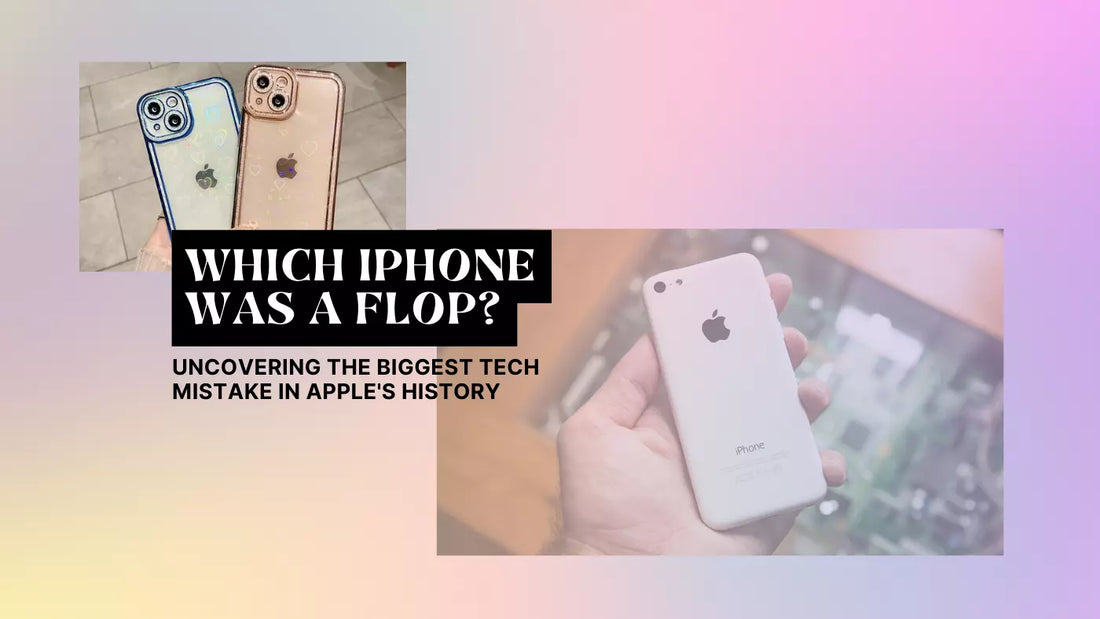
Which iPhone was a Flop? Uncovering the Biggest Tech Mistake in Apple's History
Share
Ah, the iPhone - the device that revolutionized our communication and paved the way for the smartphone era. Apple's flagship product has been the epitome of innovation and design, capturing the hearts of millions worldwide.
But did you know that even the mighty iPhone has had its share of flops? That's right! In this article, we'll dive deep into the biggest tech mistake in Apple's history and uncover the iPhone that didn't quite cut.
The biggest iPhone flop: iPhone 5c
Picture this - it's September 2013, and Apple has just unveiled its latest lineup of iPhones. Among them is the iPhone 5c, a colorful, plastic-clad sibling to the more premium iPhone 5s. Apple intended the iPhone 5c to be a more affordable option for consumers, but things could have gone better.
Sales of the iPhone 5c paled in comparison to other models. In fact, during its first quarter on the market, the iPhone 5c accounted for only 27 percent of total iPhone sales, while the iPhone 5s claimed a whopping 59 percent. So, what went wrong?
Factors that contributed to the iPhone 5c's failure
- Design and build quality: The iPhone 5c's plastic design didn't resonate with consumers who were used to Apple's premium aluminum and glass build. In a world where the iPhone was synonymous with luxury, the iPhone 5c seemed like a downgrade.
- Pricing strategy: Despite being marketed as a budget-friendly option, the iPhone 5c was still relatively expensive. At launch, the iPhone 5c was priced at $549 for the 16GB model, only $100 less than the more powerful and better-designed iPhone 5s.
- Marketing and promotion: Apple's marketing efforts for the iPhone 5c could have been better, as the company focused more on promoting the iPhone 5s. The iPhone 5c's colorful design was also a double-edged sword. It made the phone stand out and alienated some consumers who preferred a more subdued look.
The iPhone 5c's flop was a wake-up call for Apple, forcing the tech giant to reevaluate its product strategy and learn from its mistakes.
Other iPhone models that underperformed
While the iPhone 5c takes the crown as the biggest flop, other models have experienced their share of underperformance as well:
- iPhone SE (first generation): Despite offering a compact form factor and powerful specs at an affordable price, the first-generation iPhone SE's sales didn't quite reach the heights Apple had hoped for.
- iPhone X: With its revolutionary Face ID and edge-to-edge OLED display, iPhone X was a game-changer in the smartphone industry. However, its hefty price tag and controversial design choices (remember the infamous "notch"?) led to lower-than-expected sales.
- iPhone XR: The iPhone XR was Apple's attempt at offering a more affordable alternative to the iPhone XS and XS Max. While sales eventually picked up, initial demand for the iPhone XR was underwhelming.
How Apple Learned from its mistakes
Flops like the iPhone 5c served as valuable lessons for Apple, prompting the company to make significant adjustments in its product lineup:
- Pricing and design: Apple has since launched more affordable iPhones, such as the iPhone SE (2nd generation) and the iPhone 11, with premium designs and competitive pricing that cater to a wider range of consumers.
- Performance and features: The tech giant has focused on delivering cutting-edge performance, camera quality, and battery life in its newer models, ensuring that even budget-friendly iPhones maintain essential features.
- Collaboration with carriers and retailers: Apple has strengthened its partnerships with carriers and retailers to offer attractive deals and bundles, helping boost sales and visibility for its products.
The role of the media and reports in shaping public perception of iPhone flops
The media, including tech publications like ZDNet, significantly shape the public's perception of iPhone flops. Adverse reports can influence consumer sentiment and decision-making, leading to a drop in sales and demand for specific models.
Apple, in turn, has to address and manage this negative coverage to protect its brand image and maintain consumer trust.
The Future of the iPhone: Lessons from past flops
Apple's journey with the iPhone has been far from smooth sailing. Still, the company's ability to learn from past mistakes and adapt to changing market demands has been instrumental in ensuring the product's continued success.
Frequently Asked Questions
Q1: Why was the iPhone 5c considered a flop?
A1: The iPhone 5c was considered a flop due to several factors:
- Design and build quality: The plastic design departed from Apple's premium aluminum and glass build, making it seem downgraded.
- Pricing strategy: Despite being marketed as a budget-friendly option, the iPhone 5c was still relatively expensive compared to the more powerful iPhone 5s.
- Marketing and promotion: Apple's marketing efforts for the iPhone 5c could have been better. The company focused more on promoting the iPhone 5s.
Q2: Which other iPhone models underperformed in sales?
A2: Other iPhone models that underperformed include:
- iPhone SE (first generation)
- iPhone X
- iPhone XR
These models experienced lower-than-expected sales due to pricing, design choices, and competition from other smartphone manufacturers.
Q3: What lessons has Apple learned from its iPhone flops?
A3: Apple has learned several valuable lessons from its iPhone flops, which have influenced its product strategy:
- Adjusting pricing and design for different consumer segments
- Focusing on essential features like performance, camera quality, and battery life
- Strengthening partnerships with carriers and retailers to offer attractive deals and bundles
- Adapting to changing market demands and consumer needs
Q4: How does negative media coverage affect the sales and demand for iPhone models?
A4: Negative media coverage, such as reports from tech publications like ZDNet, can influence consumer sentiment and decision-making.
This can lead to a drop in sales and demand for specific iPhone models. Apple must address and manage this negative coverage to protect its brand image and maintain consumer trust.
Q5: What is the Future of the iPhone, considering the lessons learned from past flops?
A5: The Future of the iPhone will involve continuous innovation and differentiation in a saturated smartphone market. Apple must focus on understanding consumer needs and delivering products that cater to those needs.
This includes offering a range of devices with different price points, designs, and features while maintaining a strong focus on performance, camera quality, and battery life.
Conclusion
As we look forward to the Future of the iPhone, it's clear that innovation, differentiation, and a keen understanding of consumer needs will remain at the heart of Apple's product strategy.
In a saturated smartphone market, it's more important than ever for Apple to continue pushing the boundaries and delivering products that captivate and delight its loyal fanbase.
So, there you have it - the story of the iPhone's biggest flop and the lessons Apple has learned. It's a fascinating tale of trial and error and a testament to the resilience and adaptability of one of the world's most iconic brands.
I highly recommend checking out my other article master your iPhone - top 17 questions answered



